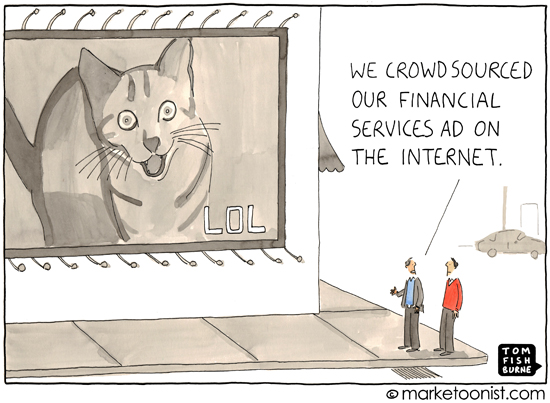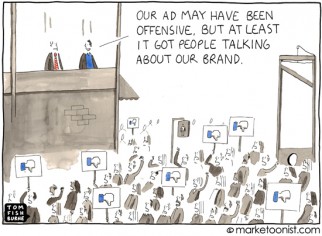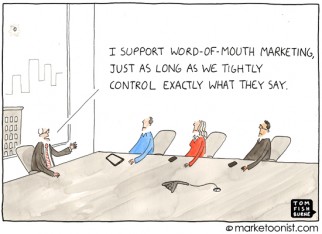Marketers are increasingly crowdsourcing aspects of their campaigns and bringing fans into the creative process. Over 20% of the ads in the last Super Bowl used some form of crowdsourcing. In February, Hasbro let a Facebook survey pick which Monopoly piece would replace the iron. Surprise, surprise, the Internet picked a cat.
Crowdsourcing can bring higher levels of engagement to a campaign and extend the buzz before and after the actual media buy. But there are different flavors of crowdsourcing. And different tactics may work for some brands better than others.
Before marketers leap on the crowdsourcing bandwagon, they need to decide the best approach for their brand, and just how much control to give away to their audiences. Giving too little control (like Audi’s lame survey to choose one of three endings to their Super Bowl ad) can fall flat. Giving too much control (like the Internet poll that picked Justin Bieber’s next tour location as North Korea) can backfire.
There is wisdom of the crowd, but it all depends on what crowd. Listening to the “crowd” can easily lead to lolcats and the lowest common denominator.
Ultimately, it comes down to the connection that brands have with their audiences. Crowdsourcing done well can channel and amplify that connection. Crowdsourcing done poorly can reveal how shallow that connection really is.
I’d love to hear your favorite examples of crowdsourcing in marketing.
(Marketoonist Monday: I’m giving away a signed print of this week’s cartoon. Just share an insightful comment to this week’s post. I’ll pick one comment at 5:00 PST on Monday. Thanks!)



Luke Murphy says
A crowd sourced coronation song for the new King of The Netherlands, didn’t really go according to plan:
http://www.newyorker.com/online/blogs/culture/2013/05/king-willem-crowdsourced-dutch-song-gone-wrong.html
Yannig says
Hi Tom,
I’ve compiled quite a lot on this interactive timeline: http://www.tiki-toki.com/timeline/entry/52997/Crowdsourcing-by-Worlds-Best-Global-Brands/ It’s being used a lot today (enough to write a PhD about it, which is what I’m doing 😉 )
Steve Schildwachter says
Tom, I’m not sure if I have a favorite crowdsourced ad, but I do have a favorite approach: Like any other advertising tool or technique, crowdsourcing must attach to the right brand, product — and strategy. Not just anybody can or should try crowdsourcing.
An important corollary: No advertiser should try crowdsourcing unless they have some experience listening to consumers. I’m not talking about focus groups, maybe social media, but no matter what the listening post, a demonstrated ability to understand their public.
OK, you *did* ask for an example. This Ford Focus commercial http://www.youtube.com/watch?feature=player_embedded&v=sZNS84fqqoc features two race car drivers and a crowd of onlookers, all of who sent smartphone video that Ford made into an ad.
By the way, there’s a crowdsourced agency, Victors & Spoils, that invites moonlighters and freelancers to submit ideas. It’s fun to be on their mailing list even though I haven’t (yet) submitted anything.
Denise Donohue says
I’ve never tried a crowdsourcing tactic, although I may have an opportunity to do so in the future. My training in p.r. says never ask questions you don’t know the answer to – foreshadowing the Justin Bieber debacle. But you don’t get the brand engagement if you only rely on old-school p.r. Perhaps the best of both worlds, and a tactic that lowers risk is crowdsourcing simple choices where you control the options. Which M&M color should we add of these options; which Monopoly piece from these options. This kind of consumer voting has been going on for a while, but social media allows much more participation. Thanks for a thought-provoking ‘toon.
Bill Carlson says
In the past we came up with concepts and did some consumer research to get a sense of what works and what doesn’t. And of course, leaning toward what the consumer told us would work.
Perceptions of research run the full range from “never make a move without it” to “who needs it”… Cost might be an issue but probably a more common consideration these days is speed to market — i.e. everybody feeling pressure to move instantaneously on everything. So there are some who might skip the research step based on… well… gut feel?
There are probably a few brands who wish they had taken a little more time and been a little more rigorous in testing consumer reactions to changes — The Gap and JCPenney logo changes come to mind. Or maybe not — probably someone at each retailer was selling the idea that all the free press and bending over backward based on consumer feedback was a good thing — all that falls into “in the eye of the beholder.”
I have often wondered about those situations — what would have happened before Facebook and all other social media? I’m not a loyal shopper at either of those retailers but to me, the logo changes were a neutral event — they didn’t change my perceptions of either retailer, and sometimes a new look is just a new look. So I didn’t run to Facebook to offer my personal opinion — and I wondered what the mix of feedback looked like across the full target market.
Anyway, crowdsourcing is in some respects a mashup of the creative and consumer research steps. If the ideas come from the target audience, it’s the same as having come up with an idea and having it test positively.
Or so we tell ourselves. Is that good enough to make a major strategic marketing decision?
Maybe, but the question is whether or not those consumers who participate in a crowdsourcing exercise are properly reflective of the overall target market?
Which kind of brings us back to the idea that for more major strategic initiatives, we should test any idea, regardless of the source.
Kristina Dolan says
I’m a huge fan of crowdsourcing and what it has done for the new marketing landscape. Adding social media into the pool, and we have an automatic tidal wave. I love the interaction crowdsourcing has brought to the conversation between brands and consumers, and I can’t wait to see what other changes come from the social-crowdsourcing relationship. http://blog.moontoast.com/blog/social-impact-on-entertainment
Sean Copeland says
I couldn’t agree more! There is a time and place for crowdsourcing and it requires a keen creative team to understand which boundaries will ensure the contributions of the crowd and the type of crowd don’t go outside of the campaign requirements and restrictions. I’m actually very eager in seeing where I can take crowdsourcing in the realms of market research as a usable source of insights. Thanks for the marketcartoon!
Concetta says
The only ad people I think do crowdsourcing really well is Doritos. Their crowdsourced Super Bowl ads are amond the funniest I’ve ever seen.
@Steve – Victor & Spoils did another of my favorite crowdsourced ads, the “No Cages” campaign by Harley Davidson. Very entertaining.
Paul (from Idea Sandbox) says
They’re replacing the iron? *sigh*
tomfishburne says
Hi all,
Really great insight, thanks! This week’s print goes to Steve. I really like the reminder that crowdsourcing is not for everyone and that it’s integrally linked with knowing how to listen to your audience. That comes first. Thanks!
-Tom
Stephan says
It’s all in German… but we crowdfunded a poster and an ad for a voting campaign. People could be part of the poster if they paid 20.- and sent us a picture. Once the ad was out people could tag themselves on the ad on facebook. The level of connection of the crowd with the campaign was awesome:
http://www.beiss-den-hai.ch/projekte/project/mieter-schwarm-plakat/